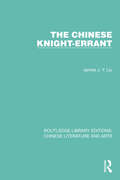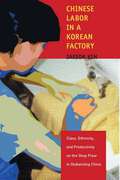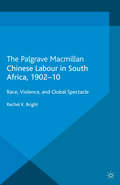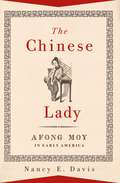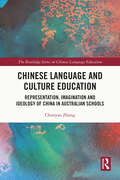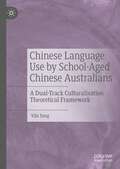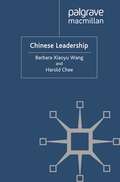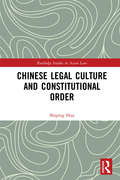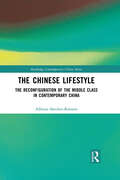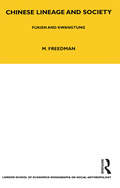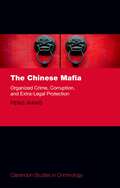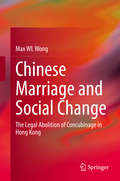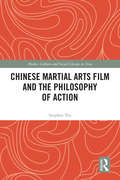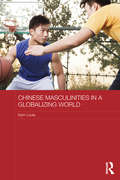- Table View
- List View
The Chinese Knight-Errant (Routledge Library Editions: Chinese Literature and Arts #8)
by James J.Y. LiuThis book, first published in 1967, is a comprehensive study of knight-errantry in Chinese history and literature from the fourth century BC to the twentieth century. After discussing the social and intellectual backgrounds of knight-errantry, it gives examples of historical knights and describes the development of the theme of knight-errantry in poetry, fiction and drama. Many biographies, anecdotes, poems and tales are translated in full, while long prose romances and dramatic works are summarized and discussed. As background to these, sketches of the developments of Chinese fiction and drama are provided. In a final chapter, comparisons are made between Chinese and European knights, and between Chinese and Western chivalric literature.
The Chinese Knight-Errant (Routledge Library Editions: Chinese Literature and Arts #8)
by James J.Y. LiuThis book, first published in 1967, is a comprehensive study of knight-errantry in Chinese history and literature from the fourth century BC to the twentieth century. After discussing the social and intellectual backgrounds of knight-errantry, it gives examples of historical knights and describes the development of the theme of knight-errantry in poetry, fiction and drama. Many biographies, anecdotes, poems and tales are translated in full, while long prose romances and dramatic works are summarized and discussed. As background to these, sketches of the developments of Chinese fiction and drama are provided. In a final chapter, comparisons are made between Chinese and European knights, and between Chinese and Western chivalric literature.
Chinese Labor in a Korean Factory: Class, Ethnicity, and Productivity on the Shop Floor in Globalizing China
by Jaesok KimChinese Labor in a Korean Factorydraws on fieldwork in a multinational corporation (MNC) in Qingdao, China, and delves deep into the power dynamics at play between Korean management, Chinese migrant workers, local-level Chinese government officials, and Chinese local gangs. Anthropologist Jaesok Kim examines how governments, to attract MNCs, relinquish parts of their legal rights over these entities, while MNCs also give up portions of their rights as proxies of global capitalism by complying with local government guidelines to ensure infrastructure and cheap labor. This ethnography demonstrates how a particular MNC struggled with the pressure to be increasingly profitable while negotiating the clash of Korean and Chinese cultures, traditions, and classes on the factory floor of a garment corporation. Chinese Labor in a Korean Factory pays particular attention to common features of post-socialist countries. By analyzing the contentious collaboration between foreign management, factory workers, government officials, and gangs, this study contributes not only to the research on the politics of resistance but also to how global and local forces interact in concrete and surprising ways.
Chinese Labour in South Africa, 1902-10: Race, Violence, and Global Spectacle (Cambridge Imperial and Post-Colonial Studies)
by R. BrightThis book explores the decision of the British Empire to import Chinese labour to southern Africa despite the already tense racial situation in the region. It enables a clearer understanding of racial and political developments in southern Africa during the reconstruction period and places localised issues within a wider historiography.
The Chinese Lady: Afong Moy in Early America
by Nancy E. DavisIn 1834, a young Chinese woman named Afong Moy arrived in America, her bound feet stepping ashore in New York City. She was both a prized guest and advertisement for a merchant firm--a promotional curiosity used to peddle exotic wares from the East. Over the next few years, she would shape Americans' impressions of China even as she assisted her merchant sponsors in selling the largest quantities of Chinese goods yet imported for the burgeoning American market. Americans views of the exotic Far East in this early period before Chinese immigration were less critical than they would later become. Afong Moy became a subject of poetry, a trendsetter for hair styles and new fashions, and a lucky name for winning racehorses. She met Americans face to face in cities and towns across the country, appearing on local stages to sell and to entertain. Yet she also moved in high society, and was the first Chinese guest to be welcomed to the White House. However, this success was not to last. As her novelty wore off, Afong Moy was cast aside by her managers. Though concerned public citizens rallied in support, her fame dwindled and she spent several years in a New Jersey almshouse. In the late 1840s, P.T. Barnum offered Afong Moy several years of promising renewal as the compatriot of Tom Thumb, yet this stint too was short-lived. In this first biography, Nancy E. Davis sheds light on the mystery of Afong Moy's life as a Chinese woman living in a foreign land.
The Chinese Lady: Afong Moy in Early America
by Nancy E. DavisIn 1834, a young Chinese woman named Afong Moy arrived in America, her bound feet stepping ashore in New York City. She was both a prized guest and advertisement for a merchant firm--a promotional curiosity used to peddle exotic wares from the East. Over the next few years, she would shape Americans' impressions of China even as she assisted her merchant sponsors in selling the largest quantities of Chinese goods yet imported for the burgeoning American market. Americans views of the exotic Far East in this early period before Chinese immigration were less critical than they would later become. Afong Moy became a subject of poetry, a trendsetter for hair styles and new fashions, and a lucky name for winning racehorses. She met Americans face to face in cities and towns across the country, appearing on local stages to sell and to entertain. Yet she also moved in high society, and was the first Chinese guest to be welcomed to the White House. However, this success was not to last. As her novelty wore off, Afong Moy was cast aside by her managers. Though concerned public citizens rallied in support, her fame dwindled and she spent several years in a New Jersey almshouse. In the late 1840s, P.T. Barnum offered Afong Moy several years of promising renewal as the compatriot of Tom Thumb, yet this stint too was short-lived. In this first biography, Nancy E. Davis sheds light on the mystery of Afong Moy's life as a Chinese woman living in a foreign land.
Chinese Language and Culture Education: Representation, Imagination and Ideology of China in Australian Schools (The Routledge Series on Chinese Language Education)
by Chunyan ZhangAgainst the background of the Australian government’s strategic plan to promote Asian languages in schools, this book is an innovative autoethnographic inquiry into what actually occurs in the implementation of a Chinese language and culture program in an Australian context.Drawing on eight years of socio-cultural and educational fieldwork in a primary school, Chunyan Zhang examines complex, fluid and heterogeneous daily teaching practices and the ways in which ideas of China are assembled, presented and performed. She asks the following questions: What is China? Where does Taiwan fit into the China depicted in a multicultural, globalised classroom? Can Chinese communism or Chairman Mao be avoided in teaching English-speaking learners? What kind of China is brought in here while what kind of China is being silenced and othered? Through the partial connection between method assemblage and Daoist concepts, Zhang develops a water-like pedagogy in teaching. She uses the knowledge flow model to examine the imbalanced knowledge flow within teacher-student interactions. From finding China as a hybrid assemblage to proposing China as method, Zhang’s investigation makes an important contribution to the sociology of Chinese language education.This book is an essential and rich content resource for primary and secondary teacher education and research, teacher candidates and educators in Chinese as a second language education.
Chinese Language and Culture Education: Representation, Imagination and Ideology of China in Australian Schools (The Routledge Series on Chinese Language Education)
by Chunyan ZhangAgainst the background of the Australian government’s strategic plan to promote Asian languages in schools, this book is an innovative autoethnographic inquiry into what actually occurs in the implementation of a Chinese language and culture program in an Australian context.Drawing on eight years of socio-cultural and educational fieldwork in a primary school, Chunyan Zhang examines complex, fluid and heterogeneous daily teaching practices and the ways in which ideas of China are assembled, presented and performed. She asks the following questions: What is China? Where does Taiwan fit into the China depicted in a multicultural, globalised classroom? Can Chinese communism or Chairman Mao be avoided in teaching English-speaking learners? What kind of China is brought in here while what kind of China is being silenced and othered? Through the partial connection between method assemblage and Daoist concepts, Zhang develops a water-like pedagogy in teaching. She uses the knowledge flow model to examine the imbalanced knowledge flow within teacher-student interactions. From finding China as a hybrid assemblage to proposing China as method, Zhang’s investigation makes an important contribution to the sociology of Chinese language education.This book is an essential and rich content resource for primary and secondary teacher education and research, teacher candidates and educators in Chinese as a second language education.
Chinese Language Use by School-Aged Chinese Australians: A Dual-Track Culturalisation Theoretical Framework
by Yilu YangThis book examines the use of Chinese by school-aged Chinese Australians from a dual-track culturalisation perspective. Drawing upon interviews, participant observations and documentary analysis, the author discusses why and how these children learn and use Chinese in multiple social settings, and how they construct their understanding of language and identities in doing so. The book will appeal to students and scholars in the fields of sociolinguistics, migration studies, sociology of education, language and communication amongst other areas in the social sciences.
Chinese Leadership
by Barbara Xiaoyu Wang Harold CheeWith the accelerating integration of China into the global economy, there is a thirst to understand how Chinese managers like to lead and how Chinese employees like to be managed. There is no doubt that China can be a difficult and risky market for foreign businesses. The authors show managers how to succeed when doing business in China.
Chinese Legal Culture and Constitutional Order (Routledge Studies in Asian Law)
by Shiping HuaThis book examines China’s striving for a constitutional order in the 20th century from comparative, historical, and theoretical perspectives. Through a comprehensive study of six major constitutional reforms experienced by China in the last century, Shiping Hua explores pragmatism, instrumentalism, statism, and favoritism as the key features of the Chinese legal culture. Demonstrating that these characteristics have roots in China’s ancient past and coincide with modern communist legal theory, it argues that Chinese legal culture has greatly impacted upon the country’s move to modernize its legal system. By analyzing key constitutional periods in China’s history, this book also evaluates patterns that can be used to better comprehend not only China’s present legal reform but its future legal developments too. As the first book to examine how the Chinese legal culture has affected constitutional reform in the 20th century, Chinese Legal Culture and Constitutional Order will be useful to students and scholars of Asian and constitutional law, as well as Chinese Studies more generally. Winner of the 2019 ACPSS (Association of Chinese Professors of Social Sciences in the United States) Best Scholarly Publication Award for Original Research.
Chinese Legal Culture and Constitutional Order (Routledge Studies in Asian Law)
by Shiping HuaThis book examines China’s striving for a constitutional order in the 20th century from comparative, historical, and theoretical perspectives. Through a comprehensive study of six major constitutional reforms experienced by China in the last century, Shiping Hua explores pragmatism, instrumentalism, statism, and favoritism as the key features of the Chinese legal culture. Demonstrating that these characteristics have roots in China’s ancient past and coincide with modern communist legal theory, it argues that Chinese legal culture has greatly impacted upon the country’s move to modernize its legal system. By analyzing key constitutional periods in China’s history, this book also evaluates patterns that can be used to better comprehend not only China’s present legal reform but its future legal developments too. As the first book to examine how the Chinese legal culture has affected constitutional reform in the 20th century, Chinese Legal Culture and Constitutional Order will be useful to students and scholars of Asian and constitutional law, as well as Chinese Studies more generally. Winner of the 2019 ACPSS (Association of Chinese Professors of Social Sciences in the United States) Best Scholarly Publication Award for Original Research.
Chinese Letters (large print)
by RnibThis image shows eight Chinese letters or characters in two rows of four. There is a locator dot shown, which will be at the top left of the page when the image is the correct way up. Each letter is labelled down from the letter image. There is a dashed line separating the images and their labels from each other. In this example all the letters are the names of types of animal. The letters are traditionally drawn with a special paintbrush or ink pen to make a pattern of marks and strokes. There are over 3,000 letters in common use. Like these examples some letters represent a whole word and some a short phrase.
Chinese Letters (UEB contracted)
by RnibThis image shows eight Chinese letters or characters in two rows of four. There is a locator dot shown, which will be at the top left of the page when the image is the correct way up. Each letter is labelled down from the letter image. There is a dashed line separating the images and their labels from each other. In this example all the letters are the names of types of animal. The letters are traditionally drawn with a special paintbrush or ink pen to make a pattern of marks and strokes. There are over 3,000 letters in common use. Like these examples some letters represent a whole word and some a short phrase.
Chinese Letters (UEB uncontracted)
by RnibThis image shows eight Chinese letters or characters in two rows of four. There is a locator dot shown, which will be at the top left of the page when the image is the correct way up. Each letter is labelled down from the letter image. There is a dashed line separating the images and their labels from each other. In this example all the letters are the names of types of animal. The letters are traditionally drawn with a special paintbrush or ink pen to make a pattern of marks and strokes. There are over 3,000 letters in common use. Like these examples some letters represent a whole word and some a short phrase.
The Chinese Lifestyle: The Reconfiguration of the Middle Class in Contemporary China (Routledge Contemporary China Series)
by Alfonso Sanchez-RomeraThe research presented in this book explores the formation of the middle class in contemporary urban China. Including case studies on middle-class professionals living in Beijing, this book analyses how social and economic changes to Chinese society create a middle-class lifestyle and new forms of distinction with a particular focus on the social construction of identity. Looking through the lens of individuals’ perception of life trajectories and ideological taxonomies generated within the framework of post-Maoist China, the book uncovers the role that the Chinese middle-class play in a state-sponsored discourse and where the distinctions identifying the middle-class lifestyle produce inequality, transfer privilege, and disadvantage in contemporary urban China. It goes on to question hegemonic discourses on class, arguing that a middle-class identity is progressively constructed in urban China not only though consumption practices, but through the experience of non-individualistic activities in both the public and private spheres. Analyzing how social distinctions are performed contributes to the understanding of the Chinese middle-class pre-pandemic, as well as the continual challenges this social group shall face in the years to come. As such, this is a must read for those interested in the Chinese middle-class, Chinese politics, and gender studies.
The Chinese Lifestyle: The Reconfiguration of the Middle Class in Contemporary China (Routledge Contemporary China Series)
by Alfonso Sanchez-RomeraThe research presented in this book explores the formation of the middle class in contemporary urban China. Including case studies on middle-class professionals living in Beijing, this book analyses how social and economic changes to Chinese society create a middle-class lifestyle and new forms of distinction with a particular focus on the social construction of identity. Looking through the lens of individuals’ perception of life trajectories and ideological taxonomies generated within the framework of post-Maoist China, the book uncovers the role that the Chinese middle-class play in a state-sponsored discourse and where the distinctions identifying the middle-class lifestyle produce inequality, transfer privilege, and disadvantage in contemporary urban China. It goes on to question hegemonic discourses on class, arguing that a middle-class identity is progressively constructed in urban China not only though consumption practices, but through the experience of non-individualistic activities in both the public and private spheres. Analyzing how social distinctions are performed contributes to the understanding of the Chinese middle-class pre-pandemic, as well as the continual challenges this social group shall face in the years to come. As such, this is a must read for those interested in the Chinese middle-class, Chinese politics, and gender studies.
Chinese Lineage and Society: Fukien and Kwantung Volume 33
by Maurice FreedmanThis book takes the argument first set out in Lineage Organization in South-Eastern China a step further. It incorporates some of Professor Freedman's field data (gathered in the Hong Kong New Territories in 1963) and draws on a wide variety of written sources. As in his first book on the subject, the author seeks to analyse certain crucial institutions of Chinese society within the framework of contemporary anthropological theory.
Chinese Lineage and Society: Fukien and Kwantung Volume 33
by Maurice FreedmanThis book takes the argument first set out in Lineage Organization in South-Eastern China a step further. It incorporates some of Professor Freedman's field data (gathered in the Hong Kong New Territories in 1963) and draws on a wide variety of written sources. As in his first book on the subject, the author seeks to analyse certain crucial institutions of Chinese society within the framework of contemporary anthropological theory.
The Chinese Mafia: Organized Crime, Corruption, and Extra-Legal Protection (Clarendon Studies in Criminology)
by Peng WangUtilising individual interviews and focus group discussions, primarily from two Chinese cities, The Chinese Mafia: Organized Crime, Corruption, and Extra-Legal Protection contributes to the understanding of organized crime and corruption in the Chinese context, filing a significant gap in criminological literature, by investigating how extra-legal protectors-corrupt public officials and street gangsters-emerge, evolve and operate in a rapidly changing society. China's economic reforms have been accompanied by a surge of social problems, such as ineffective legal institutions, booming black markets and rampant corruption. This has resulted in the rise of extra-legal means of protection and enforcement: such is the demand for protection that cannot be fulfilled by state-sponsored institutions. This book develops a new socio-economic theory of mafia emergence, incorporating Granovetter's argument on social embeddedness into Gambetta's economic theory of the mafia, to suggest that the rise of the Chinese mafia is primarily due to the negative influence of guanxi (a Chinese version of personal connections) on the effectiveness of the formal legal system. This interplay has two major consequences. First, the weakened ability of the formal legal system sees street gangsters (the 'Black Mafia') providing protection and quasi law enforcement. Second, it allows for escalating abuse of power by public officials; as a result, corrupt officials (the 'Red Mafia') sell public appointments, exchange illegal benefits with businesses and protect local gangs. Together, these outcomes have seen street gangs shift their operations away from traditional areas (e.g. gambling, prostitution and drug distribution), whilst corrupt public officials have moved to offer illegal services to the criminal underworld, including the safeguarding organized crime groups and protection of illegal entrepreneurs. A study of crime and deviance located within a fast growing economy, The Chinese Mafia offers a unique understanding of these activities within contemporary Chinese society and a new perspective for understanding the interaction between corruption and organized crime. It will be of interest to academics and students engaged in the fields of criminology and criminal justice, sociology, and political science, with particular interest for those researching China and Chinese politics and governance.
The Chinese Mafia: Organized Crime, Corruption, and Extra-Legal Protection (Clarendon Studies in Criminology)
by Peng WangUtilising individual interviews and focus group discussions, primarily from two Chinese cities, The Chinese Mafia: Organized Crime, Corruption, and Extra-Legal Protection contributes to the understanding of organized crime and corruption in the Chinese context, filing a significant gap in criminological literature, by investigating how extra-legal protectors-corrupt public officials and street gangsters-emerge, evolve and operate in a rapidly changing society. China's economic reforms have been accompanied by a surge of social problems, such as ineffective legal institutions, booming black markets and rampant corruption. This has resulted in the rise of extra-legal means of protection and enforcement: such is the demand for protection that cannot be fulfilled by state-sponsored institutions. This book develops a new socio-economic theory of mafia emergence, incorporating Granovetter's argument on social embeddedness into Gambetta's economic theory of the mafia, to suggest that the rise of the Chinese mafia is primarily due to the negative influence of guanxi (a Chinese version of personal connections) on the effectiveness of the formal legal system. This interplay has two major consequences. First, the weakened ability of the formal legal system sees street gangsters (the 'Black Mafia') providing protection and quasi law enforcement. Second, it allows for escalating abuse of power by public officials; as a result, corrupt officials (the 'Red Mafia') sell public appointments, exchange illegal benefits with businesses and protect local gangs. Together, these outcomes have seen street gangs shift their operations away from traditional areas (e.g. gambling, prostitution and drug distribution), whilst corrupt public officials have moved to offer illegal services to the criminal underworld, including the safeguarding organized crime groups and protection of illegal entrepreneurs. A study of crime and deviance located within a fast growing economy, The Chinese Mafia offers a unique understanding of these activities within contemporary Chinese society and a new perspective for understanding the interaction between corruption and organized crime. It will be of interest to academics and students engaged in the fields of criminology and criminal justice, sociology, and political science, with particular interest for those researching China and Chinese politics and governance.
Chinese Marriage and Social Change: The Legal Abolition of Concubinage in Hong Kong
by Max WL WongThis book provides a comparative account of the abolition of concubinage in East Asia, offering a new perspective and revised analysis of the factors leading to – and the debates surrounding – the introduction of a new Marriage Reform Ordinance in Hong Kong in 1971. It uses this law as a platform to examine how the existence of concubinage – long preserved in the name of protecting Chinese traditions and customs — crucially influenced family law reforms, which were in response to a perceived need to create a ‘modern’ marriage system within Hong Kong’s Chinese community after the Second World War. This was, by and large, the result of continued pressure from within Hong Kong and from Britain to bring Hong Kong’s marriage system in line with international marriage treaties. It represented one of the last significant intrusions of colonial law into the private sphere of Hong Kong social life, eliminating Chinese customs which had been previously recognised by the colonial legal system’s family law. This book contextualizes the Hong Kong situation by examining judicial cases interpreting Chinese customs and the Great Qing Code, offering a comprehensive understanding of the Hong Kong situation in relation to the status of concubines in Republican China and other East Asian jurisdictions. It will be of particular interest to teachers and students of law, as well as researchers in gender studies, post-colonialism, sociology and cultural studies.
Chinese Martial Arts Film and the Philosophy of Action (Media, Culture and Social Change in Asia)
by Stephen TeoThis book focuses on the philosophy of Chinese martial arts film, arguing that philosophy provides a key to understanding the whole genre. It draws on Chinese philosophical ideas derived from, or based on, Confucianism, Daoism, Buddhism, and other schools of thought such as Mohism and Legalism, examines a cluster of recent Chinese martial arts films centering on the figure of the xia—the heroic protagonist, the Chinese equivalent of medieval Europe’s knight-errant—and outlines the philosophical principles and themes undergirding the actions of xia and their narratives. Overall, the author argues that the genre, apart from being an action-oriented entertainment medium, is inherently moral and ethical.
Chinese Martial Arts Film and the Philosophy of Action (Media, Culture and Social Change in Asia)
by Stephen TeoThis book focuses on the philosophy of Chinese martial arts film, arguing that philosophy provides a key to understanding the whole genre. It draws on Chinese philosophical ideas derived from, or based on, Confucianism, Daoism, Buddhism, and other schools of thought such as Mohism and Legalism, examines a cluster of recent Chinese martial arts films centering on the figure of the xia—the heroic protagonist, the Chinese equivalent of medieval Europe’s knight-errant—and outlines the philosophical principles and themes undergirding the actions of xia and their narratives. Overall, the author argues that the genre, apart from being an action-oriented entertainment medium, is inherently moral and ethical.
Chinese Masculinities in a Globalizing World (Routledge Culture, Society, Business in East Asia Series)
by Kam LouieThis book explores how the traditional ideal of Chinese manhood – the "wen" (cultural attainment) and "wu" (martial prowess) dyad – has been transformed by the increasing integration of China in the international scene. It discusses how increased travel and contact between China and the West are having a profound impact; showing how increased interchange with Western men, for whom "wu" is a more significant ideal, has shifted the balance in the classic Chinese dichotomy; and how the huge emphasis on wealth creation in contemporary China has changed the notion of "wen" itself to include business management skills and monetary power. The book also considers the implications of Chinese "soft power" outside China for the reconfigurations in masculinity ideals in the global setting. The rising significance of Chinese culture enables Chinese cultural norms, including ideals of manhood, to be increasingly integrated in the international sphere and to become hybridised. The book also examines the impact of the Japanese and Korean waves on popular conceptions of desirable manhood in China. Overall, it demonstrates that social constructions of Chinese masculinity have changed more fundamentally and become more global in the last three decades than any other time in the last three thousand years.
